MENU
MENU
Tea production area: Shikokuchuo City, Saijo City, Seiyo City, Kihoku Town, Tomisato Town, Matsuno Town, Kumakogen Town
Brand: Shingutea, Ishizuchikurocha, Uwa tea, Kihoku tea, Kuma tea, Mikawa tea
Types of tea: Sencha (medium steamed green tea), dark tea (post-fermentation tea), hojicha, bancha, black tea, matcha, etc.
Tea cultivated in mountainous regions
There are many tea production areas in the Shikoku Mountains of Ehime Prefecture. Sencha is mainly produced in these areas.
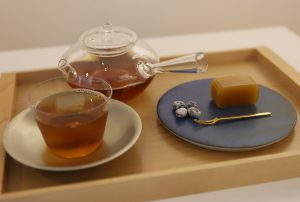
Mustakivi’s hojicha of Singu tea and Ehime mikan yokan (August 2019)
Shingu tea
Shingu Town, Shikokuchuo City is one of the main tea production areas in Shikoku. Yamacha (wild tea) originally grew naturally in Shingu Town. Using beneficial insects which eat harmful insects against tea plants, full-scale tea cultivation began in 1952. The tea farmers work on cultivation without chemicals across the whole region since 1985. Additionally, Kaya grown around the tea fields is cut and put in the tea fields.
*Kaya is another name for Japanese pampas grass, reeds, and cypress which are gramineous perennial grasses.

Tea field with kaya in Shingu Town (January 2023)
Kirinomori
There is a large-scale tourist facility “Kirinomori”
There is a large-scale tourist facility “Kirinomori” where visitors enjoy Shingu tea, nature and natural hot spring
in Shingu Town. There are a café, restaurant, shop, confectionery factory, hot spring facility, museum, cottage there.
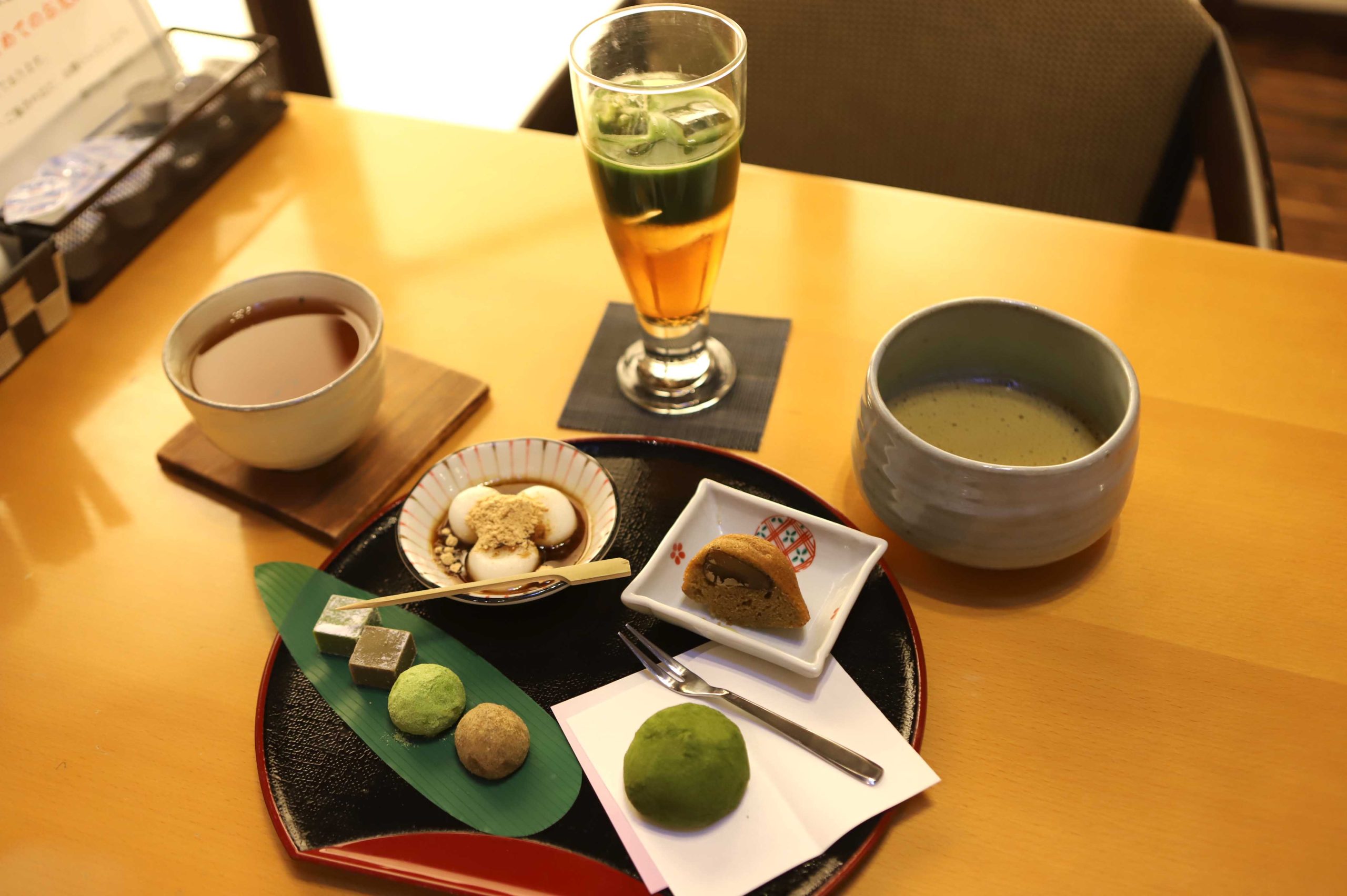
Shingu tea cafe Yururi (January 2023)
Ishizuchikuro-cha (Ishizuchikuro tea)
Mt. Ishizuchisan and Ishizuchikuro-cha
Ishizuchikuro-cha is post-fermented tea made in a two-stage fermentation process. This tea is produced in Saijo City.
Mt. Ishizuchi-san is in Ehime Prefecture and belongs to the Shikoku Mountains being the highest mountain in the Shikoku Region. It is also known as a place for the worship of mountains and is a place of Shugendo. Shugendo is Japanese mountain asceticism-shamanism incorporating both Shinto and Buddhist concepts.
Many people visit Mt. Ishizuchi-san where Ishizuchikuro-cha is served to visitors by local people.
History of Ishizuchikuro-cha
The origin of Ishizuchikuro-cha is unknown, but there are a few local traditions. One is that a Buddhist monk Kukai introduced the production method of post-fermentation tea from Tang (China) where he studied Chinese Buddhism in the 9th century. It is said that Kukai pilgrimaged and trained on Mt. Ishizuchisan after he came back from Tang to Japan.
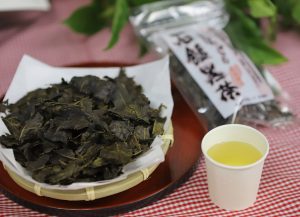
Satsukikai’s Ishizuchikuro-cha (August 2019)
Much Ishizuchikuro-cha tea was produced from the end of Edo Period to the Taisho Period. The number of producers gradually decreased from the Showa Period (beginning in 1926) eventually resulting in one household who was an elderly couple.
The citizen group, “Satsukikai” learned the method of producing the tea from the couple in order to keep Ishizuchikuro-cha from dying out. Presently Satsukikai and 2 local disability employment training farms are producing and selling Ishizuchikuro-cha.
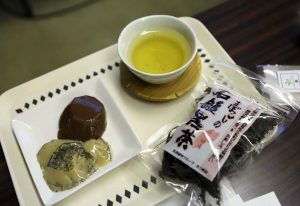
Sweets using Ishizuchikuro-cha which are made by high school students
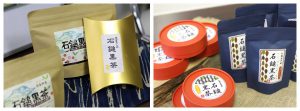
Photo left: Peace’s Ishizuchikuro-cha, Photo right: Visse’s Ishizuchikuro-cha
The method of producing Ishizuchikuro-cha
1. Branches of tea plants with leaves are plucked from the end of June until the beginning of July. These are then washed and steamed in a large caldron for about 1 hour on the day of the plucking.
2. After the steaming, the tea leaves are removed from the branches and placed with the broth which was made from the steaming in a wooden bucket for approximately a week. Aerobic fermentation is then carried out by adding mold as the first fermentation.
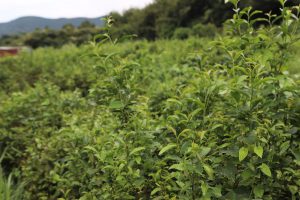
Tea fields which Satsukikai manages (August 2019)
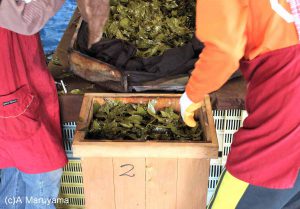
Putting tea leaves into a wooden bucket at Satsukikai’s workshop (July 2019)
Photo provided by A Maruyama
3. The tea leaves are removed from the wooden bucket and rolled on a wooden washboard in order to scratch the tea leaves. The scratches then promote the second fermentation. They are next put inside a plastic bag which is placed in a plastic container. Stone weights are placed on the container for about 2 weeks so that anaerobic fermentation is carried out with lactic acid bacteria as the second fermentation.
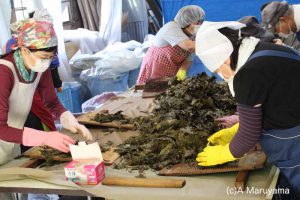
Rolling tea leaves on a wooden washboard at Satsukikai’s workshop (July 2019)
Photo provided by A Maruyama
4. The tea leaves are taken out of the bag and the twigs are removed. Then the tea leaves are dried in the sun for 2 consecutive sunny days.
How to drink Ishizuchikuro-cha
According to the local people, the method for making Ishizuchikuro-cha is done by brewing the tea leaves in a kyusu (teapot) or boiling them in a pan of water. Either method is ok.
Ishizuchikuro-cha has a sharp sour acidic flavor. The flavor is matured by keeping the tea leaves in a dark and cool place for 2 or 3 years.
Recordable folk cultural property
In 2018, Ishizuchikuro-cha, Goishi-cha and Awa bancha were designated as “recordable folk cultural property” for their fermented tea producing technology in the Shikoku Region. In 2023, the production method of Ishizuchikuro-cha was designated an Important Intangible Folk Cultural Property of Japan.
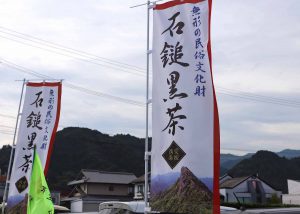
Komatsunoson-kankyokaizen center in Saijo City (August 2019)
Bancha (番茶・晩茶):
Originally bancha means coarse tea in contrast with sencha (medium-steamed green tea). Sencha is produced with new tender tea leaves which plucked in the first tea season in Japan. Bancha is produced with matured hard tea leaves and stems plucked in the late season of the first tea season or in autumn. Shuto bancha means steamed green tea produced with tea leaves plucked in the autumn and early winter.
Related article on the site:
Tea related facility: 霧の森 http://www.kirinomori.co.jp
Tea mascot Yuru-Chara:
Ceramic and pottery art: Tobe ware
Reference:
松下智 (平成3年) 日本名茶紀行 (初版) 雄山閣出版
高野實・谷本陽蔵・富田勲・中川致之・岩浅潔・寺本益英・山田新市 (2005) 緑茶の事典 (改訂3版) 柴田書店
大森正司、阿南豊正、伊勢村護、加藤みゆき、滝口明子、中村羊一郎編(2017) 茶の事典 初版第一刷 朝倉書店
四国中央市 https://www.city.shikokuchuo.ehime.jp
新宮茶
https://www.city.shikokuchuo.ehime.jp/soshiki/24/1639.html
JAうま http://www.ja-uma.or.jp お茶セット(新宮茶・富郷茶)
西条市 石鎚黒茶
https://www.city.saijo.ehime.jp
https://www.city.saijo.ehime.jp/soshiki/sangyoshinko/ishidutikurocya.html
さつき会石鎚黒茶
https://kurocha.buyshop.jp/
NPO法人石鎚スクエア就労継続支援B型事業就労継続支援B型事業所Visee
社会福祉法人西条市氷見福祉協会氷見授産場障害者事業ピース
文化庁 報道発表 平成30年1月19日 文化審議会答申(重要無形民俗文化財の指定等)
https://www.bunka.go.jp/
https://www.bunka.go.jp/koho_hodo_oshirase/hodohappyo/__icsFiles/afieldfile/2018/01/18/a1400149_01.pdf
ムスタキビMustakivi http://www.mustakivi.jp
写真「新宮茶のほうじ茶と愛媛みかん羊羹(2019年8月)」はMustakiviで撮影しました(Mustakiviのカフェは閉店しました)。
*When visiting the shops and facilities introduced in this article, please check the business hours on their website, etc. before visiting.
*The information provided on this site may be updated. If you find any information in this article that is incorrect, new, or incomplete, please contact CHAMART.
*The site does not describe all “Teas of Japan” or all “Teas of the World”. Additionally, each article expresses the writer’s personal experience and feelings.
#ishizuchikurocha #ehime #saijo #ishizuchi